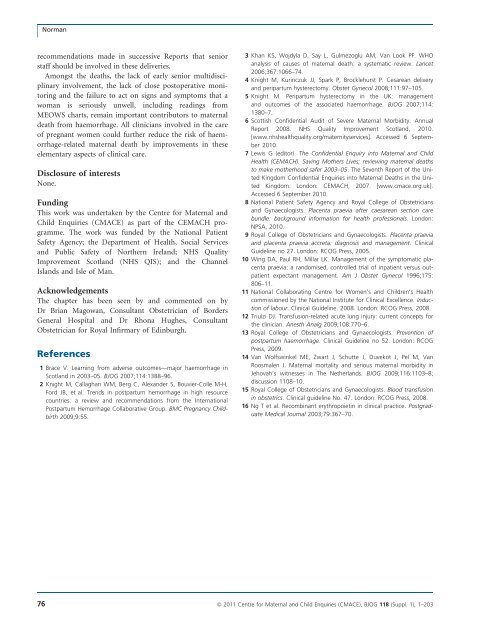6.-March-2011-Saving-Mothers-Lives-reviewing-maternal-deaths-to-make-motherhood-safer-2006-2008
6.-March-2011-Saving-Mothers-Lives-reviewing-maternal-deaths-to-make-motherhood-safer-2006-2008
6.-March-2011-Saving-Mothers-Lives-reviewing-maternal-deaths-to-make-motherhood-safer-2006-2008
You also want an ePaper? Increase the reach of your titles
YUMPU automatically turns print PDFs into web optimized ePapers that Google loves.
Normanrecommendations made in successive Reports that seniorstaff should be involved in these deliveries.Amongst the <strong>deaths</strong>, the lack of early senior multidisciplinaryinvolvement, the lack of close pos<strong>to</strong>perative moni<strong>to</strong>ringand the failure <strong>to</strong> act on signs and symp<strong>to</strong>ms that awoman is seriously unwell, including readings fromMEOWS charts, remain important contribu<strong>to</strong>rs <strong>to</strong> <strong>maternal</strong>death from haemorrhage. All clinicians involved in the careof pregnant women could further reduce the risk of haemorrhage-related<strong>maternal</strong> death by improvements in theseelementary aspects of clinical care.Disclosure of interestsNone.FundingThis work was undertaken by the Centre for Maternal andChild Enquiries (CMACE) as part of the CEMACH programme.The work was funded by the National PatientSafety Agency; the Department of Health, Social Servicesand Public Safety of Northern Ireland; NHS QualityImprovement Scotland (NHS QIS); and the ChannelIslands and Isle of Man.AcknowledgementsThe chapter has been seen by and commented on byDr Brian Magowan, Consultant Obstetrician of BordersGeneral Hospital and Dr Rhona Hughes, ConsultantObstetrician for Royal Infirmary of Edinburgh.References1 Brace V. Learning from adverse outcomes—major haemorrhage inScotland in 2003–05. BJOG 2007;114:1388–9<strong>6.</strong>2 Knight M, Callaghan WM, Berg C, Alexander S, Bouvier-Colle M-H,Ford JB, et al. Trends in postpartum hemorrhage in high resourcecountries: a review and recommendations from the InternationalPostpartum Hemorrhage Collaborative Group. BMC Pregnancy Childbirth2009;9:55.3 Khan KS, Wojdyla D, Say L, Gulmezoglu AM, Van Look PF. WHOanalysis of causes of <strong>maternal</strong> death: a systematic review. Lancet<strong>2006</strong>;367:1066–74.4 Knight M, Kurinczuk JJ, Spark P, Brocklehurst P. Cesarean deliveryand peripartum hysterec<strong>to</strong>my. Obstet Gynecol <strong>2008</strong>;111:97–105.5 Knight M. Peripartum hysterec<strong>to</strong>my in the UK: managementand outcomes of the associated haemorrhage. BJOG 2007;114:1380–7.6 Scottish Confidential Audit of Severe Maternal Morbidity. AnnualReport <strong>2008</strong>. NHS Quality Improvement Scotland, 2010.[www.nhshealthquality.org/maternityservices]. Accessed 6 September2010.7 Lewis G (edi<strong>to</strong>r). The Confidential Enquiry in<strong>to</strong> Maternal and ChildHealth (CEMACH). <strong>Saving</strong> <strong>Mothers</strong> <strong>Lives</strong>; <strong>reviewing</strong> <strong>maternal</strong> <strong>deaths</strong><strong>to</strong> <strong>make</strong> <strong>motherhood</strong> <strong>safer</strong> 2003–05. The Seventh Report of the UnitedKingdom Confidential Enquiries in<strong>to</strong> Maternal Deaths in the UnitedKingdom. London: CEMACH, 2007. [www.cmace.org.uk].Accessed 6 September 2010.8 National Patient Safety Agency and Royal College of Obstetriciansand Gynaecologists. Placenta praevia after caesarean section carebundle: background information for health professionals. London:NPSA, 2010.9 Royal College of Obstetricians and Gynaecologists. Placenta praeviaand placenta praevia accreta: diagnosis and management. ClinicalGuideline no 27. London: RCOG Press, 2005.10 Wing DA, Paul RH, Millar LK. Management of the symp<strong>to</strong>matic placentapraevia: a randomised, controlled trial of inpatient versus outpatientexpectant management. Am J Obstet Gynecol 1996;175:806–11.11 National Collaborating Centre for Women’s and Children’s Healthcommissioned by the National Institute for Clinical Excellence. Inductionof labour. Clinical Guideline. <strong>2008</strong>. London: RCOG Press, <strong>2008</strong>.12 Triulzi DJ. Transfusion-related acute lung injury: current concepts forthe clinician. Anesth Analg 2009;108:770–<strong>6.</strong>13 Royal College of Obstetricians and Gynaecologists. Prevention ofpostpartum haemorrhage. Clinical Guideline no 52. London: RCOGPress, 2009.14 Van Wolfswinkel ME, Zwart J, Schutte J, Duvekot J, Pel M, VanRoosmalen J. Maternal mortality and serious <strong>maternal</strong> morbidity inJehovah’s witnesses in The Netherlands. BJOG 2009;116:1103–8;discussion 1108–10.15 Royal College of Obstetricians and Gynaecologists. Blood transfusionin obstetrics. Clinical guideline No. 47. London: RCOG Press, <strong>2008</strong>.16 Ng T et al. Recombinant erythropoietin in clinical practice. PostgraduateMedical Journal 2003;79:367–70.76 ª <strong>2011</strong> Centre for Maternal and Child Enquiries (CMACE), BJOG 118 (Suppl. 1), 1–203


